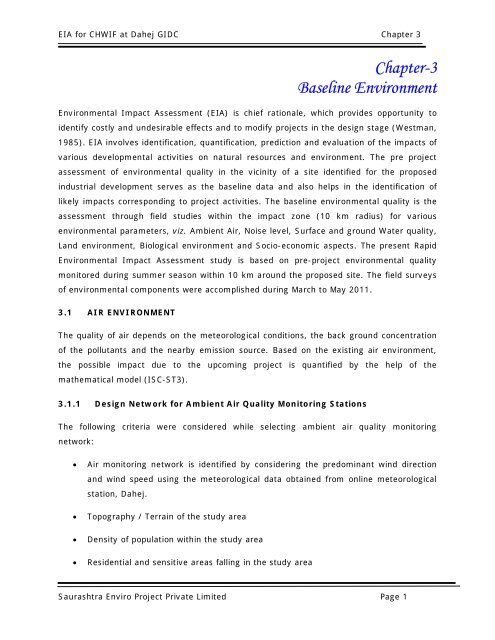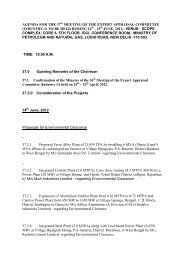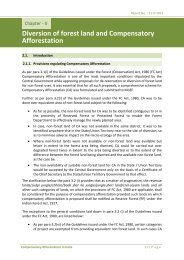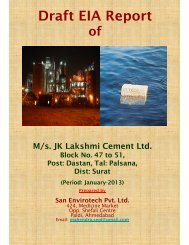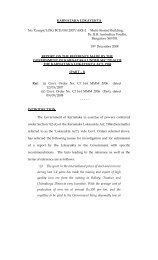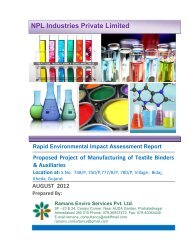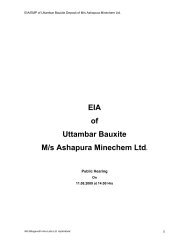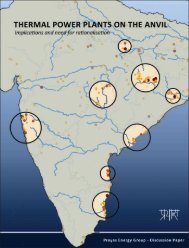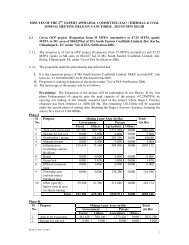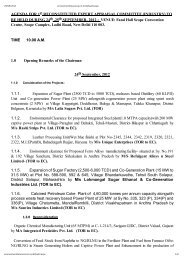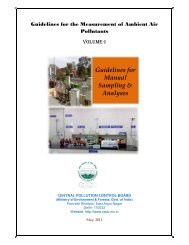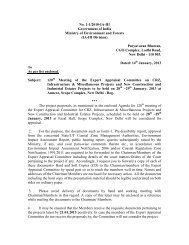Chapter-3 Baseline Environment - eRc India
Chapter-3 Baseline Environment - eRc India
Chapter-3 Baseline Environment - eRc India
You also want an ePaper? Increase the reach of your titles
YUMPU automatically turns print PDFs into web optimized ePapers that Google loves.
EIA for CHWIF at Dahej GIDC <strong>Chapter</strong> 3Meteorological data at the project site during study period is an essential requirement forproper interpretation of baseline air quality status. The same data is also useful in predictionof possible impacts through the mathematical modeling.3.1.2 Meteorology of study areaMeteorological data were collected on hourly basis by installing online meteorological stationin study area and same has been used for the plotting of wind rose. The principlemeteorological variables are horizontal convective transport (average wind speed anddirection), vertical convective transport (atmospheric stability, mixing height) andtopography of the area. The micrometeorological conditions at the project site will regulatethe transport and diffusion of air pollutants released into the atmosphere. Meteorologicalparameter fluctuation during the study period is described below:TemperatureThe temperature in the study area varied between 17 0 C- 43 0 C during the study period.Relative HumidityThe relative humidity in the study area varied between 12 % to 91 %.Wind SpeedThe wind speed in the study area was observed to be between 0 m/s to 14 m/s. Theaverage wind speed in the area was 2.54 m/s.Wind DirectionFrom the wind rose diagram (Fig. 3.1) it is observed that predominant wind direction isSouth West to North East.Saurashtra Enviro Project Private Limited Page 2
EIA for CHWIF at Dahej GIDC <strong>Chapter</strong> 3Figure 3.1: Wind Rose DiagramSaurashtra Enviro Project Private Limited Page 3
EIA for CHWIF at Dahej GIDC <strong>Chapter</strong> 33.1.3 Existing Air qualityAmbient air quality was monitored twice in week for 24 hourly basis as per standardguidelines of CPCB and NAAQS. The conventional and project specific parameters such asPM 10 , PM 2.5 , Sulphur Dioxide (SO 2 ), oxides of nitrogen (NOx), HCl and CO were monitored atdifferent monitoring locations within 10 Km radius from the project site during the studyperiod.3.1.3.1 Air monitoring locationsTotal of 6 locations were considered for study of air quality within 10 Km radius from theproposed project site. Based on the prevailing wind direction and as per the guidelines ofMoEF and CPCB two downwind sites and one upwind site with respect to the project locationwere monitored for air quality apart from the project site itself. The air monitoring locationsare depicted on the study area map (Fig 3.2).Saurashtra Enviro Project Private Limited Page 4
EIA for CHWIF at Dahej GIDC <strong>Chapter</strong> 3Figure 3.2: Air Sampling LocationsAQ 6AQ 5AQ 1AQ 4AQ 2AQ 3Saurashtra Enviro Project Private Limited Page 5
EIA for CHWIF at Dahej GIDC <strong>Chapter</strong> 3The direction of monitoring station with respect to project site is given in the table 3.1below.Table 3.1: Air monitoring locationsVillage Sampling code DirectionVdadala Project site AQ 1 --Ambetha AQ 2 South- WestSuva AQ 3 South-EastJolva AQ 4 South-EastKadodara AQ 5 North-EastPadriya AQ 6 North-East3.1.3.2 Method of AnalysisThe different analysis method used for different pollutants with the minimum detection limitis given in the table below.Table 3.2: Analysis methods and Instrument detailsSrNo.Name OfParameterMonitoringTechnique1 PM10 IS 5182 (Pt23)2 PM2.5---3 SO2 IS-5182(part2):2001EPA modifiedWest andGaekemethod4 NOx IS-5182(part6):2006Jacobs –Hochheisermethod –First revision5 HCl GPCBScientificManualSection- 3DetectionLimitPermissibleStandards as perEPA/SPCB/GPCBInstrument Details1 μg/m 3 100 μg/m 3 Respirable Dustsampler2.0 μg/m 3 60 μg/m 3 Fine Particulatesampler0.5 μg/m 3 80 μg/m 3 Gas sampler attachedto Respirable Dustsampler / UV-VISSpectro Photometer5.5 μg/m 3 80 μg/m 3 Gas sampler attachedto Respirable Dustsampler / UV –VISSpectro Photometer2.0 µg /m3 --- Titrimetric MethodSaurashtra Enviro Project Private Limited Page 6
EIA for CHWIF at Dahej GIDC <strong>Chapter</strong> 36 CO IS – 5182(Part – 10):1999114.5µg / m32000 μg/m 3 (8hourly)Gas ChromatographyMethod3.1.3.3 <strong>Baseline</strong> DataThe average concentration of the environment parameters along with the minimum andmaximum concentrations for the study period at the monitoring locations are given in table3.3.Table 3.3: Concentration of Various pollutantsParametersPM 10(µg/m 3 )PM 2.5(µg/m 3 )SO 2 (μg/m 3 )NO X (μg/m 3 )ObservedvaluesSAMPLING LOCATIONSAQ 1 AQ 2 AQ 3 AQ 4 AQ5 AQ6Min. 40.60 40.79 39.93 40.52 47 80Max. 62.25 72.42 65.14 63.46 109 112Avg. 48.24 50.96 46.80 51 90 9598th 60.51 69 63.18 63.11 104 110PercentileMin. 19.32 20.05 18.99 20.18 26.9 33Max. 29.16 33.27 30.46 29.61 35.5 35.3Avg. 23.28 24.62 22.92 24.79 34.1 3498th 28.24 29.37 30.45 29.37 35.4 35.3PercentileMin. 2.94 3.11 4.32 4.46 4 4Max. 5.77 10.88 10.7 10.6 10 9Avg. 4.34 6.51 6.68 6.8 6.29 6.3898th 5.57 9.66 9.55 10.2 9.54 9PercentileMin. 9.27 11.85 11.4 11.1 12 12Max. 16.4 21.17 22.6 23.8 20 20Avg. 13.11 16.6 16.2 16 15.50 15.898th 16.40 21.15 22.3 23.1 19.54 20PercentileMin. 450 482 462 490 451 459CPCBStandards(24hourly)100 μg/m 360 μg/m 380 μg/m 380 μg/m 3Max. 570 563 559 560 561 557 2000 μgCO (μg /m3) Avg. 501 523 523 523 522 522/m398th 566 562 559 558.16 560.54 557PercentileHCl (ppm) Min. ND ND ND ND ND ND ‐‐‐Saurashtra Enviro Project Private Limited Page 7
EIA for CHWIF at Dahej GIDC <strong>Chapter</strong> 3Max. ND ND ND ND ND NDAvg. ND ND ND ND ND ND98thPercentileND ND ND ND ND NDPM 10The level of PM 10 varies between 39.93 µg/m 3concentration of PM 10 was found to be 90 µg/m 3 at Padriya.to 112 µg/m 3 . The maximum averagePM 2.5The minimum and maximum value for PM 2.5 was found to be between 18.99 µg/m 3 to 35.5µg/m 3 . The maximum average concentration observed at Kadodara i.e. 34.1 µg/m 3 , whichmay be due to vehicular movements in the village road. Concentration of PM2.5 for all siteswas well below permissible limits.Saurashtra Enviro Project Private Limited Page 8
EIA for CHWIF at Dahej GIDC <strong>Chapter</strong> 3SO 2The maximum average concentration of sulphur dioxide in the study area was observed as6.8 µg/m 3 at Jolva village, where as the minimum and maximum value ranges between2.94 µg/m 3 to 10.88 µg/m 3 .Saurashtra Enviro Project Private Limited Page 9
EIA for CHWIF at Dahej GIDC <strong>Chapter</strong> 3NO xThe nitrogen dioxide concentration in the study area varied between 9.27 µg/m 3 to 23.8µg/m 3 . Maximum average concentration was found at Ambetha village i.e. 16.6 µg/m 3 , butit is below permissible level.HClThe minimum and maximum value for HCl was found as non detectable.COThe minimum and maximum value for CO was found to be between 450 µg/m 3 to 570µg/m 3 .3.2 WATER ENVIRONMENTThe existing water quality in the study area, with respect to ground water and surface waterwas evaluated during the study period. The ground water table is very shallow, available atan average depth of approximately 7.20 m near the project site. Surface water sampleswere collected from the various existing inland water bodies located near the villages.Ground water samples were collected from the existing open wells and hand pumps in thestudy area. All together 5 ground water samples and 4 surface water samples collected forthe evaluation of water quality.Saurashtra Enviro Project Private Limited Page 10
EIA for CHWIF at Dahej GIDC <strong>Chapter</strong> 33.2.1 Water Sampling LocationThe details of sampling location with the distance and direction with respect to project siteare given in following table no. 3.4.Table 3.4: Water monitoring locationSamplingStationSource ofwaterSamplingcodeRahiyad Ground water GW 1Kadodara Ground water GW 2Padriya Ground water GW 3Paniadra Ground water GW 4Suva Ground water GW 5Jolva Surface water SW 1Rahiyad Surface water SW 2Kadodara Surface water SW 3Vaddala Surface water SW 4Saurashtra Enviro Project Private Limited Page 11
EIA for CHWIF at Dahej GIDC <strong>Chapter</strong> 3Figure 3.3: Water Monitoring locationsGW4GW3GW2SW3SW4SW1SW2GW13.2.2 Analysis MethodThe different analysis method used for measuring different parameters in water is given inthe table below:Saurashtra Enviro Project Private Limited Page 12
EIA for CHWIF at Dahej GIDC <strong>Chapter</strong> 3Table 3.5: Method of AnalysisSR. No.PARAMETERSApplicable standard methodof analysisDetectionlimitDesirablelimits(Permissible limit)PHYSICAL PARAMETERS1. pH Electrometric method IS-3025(part 11)-19832. Conductivity (µmho/cm) IS-3025(part 14) 19841st Revision 19963. Turbidity (NTU) IS-3025(part 10)-19841st Rev – Reaffirmed 19964. Total Dissolved Solids Gravimetric method IS-(TDS) (mg/l)3025(part 16)-19845. Total Suspended Solids Gravimetric method IS-(mg/l)3025(part 17)-1984Reaffirmed 1998 1st RevINORGANIC PARAMETERS6. Chlorides (mg/l) Argentometric titration IS-3025(part 32)-1988Reaffirmed 19997. Total Hardness as CaCO3(mg/l)EDTA-titrametric methodAPHA & AWWA 21st edition2340C2-378. Sulphates (mg/l) Turbidity method IS-3025(part24)-1986Reaffirmed 19920.1 6.5 – 8.51 --0 5 NTU( 10)4 500 mg/l(2000 mg/l)4 --1 250 mg/l(1000 mg/l)2 300 mg/l(600 mg/l)2 200 mg/l(400 mg/l)9. Flouride (mg/L) APHA & AWWA 0.05 1.0 mg/l(1.5 mg/l)10. Calcium mg/L APHA & AWWA 2.0 75 mg/l(200)11. Magnesium mg/L APHA & AWWA 2.0 30 mg/l(100)12. Sodium mg/L APHA & AWWA 2.0 NS13. Potassium mg/L APHA & AWWA 2.0 NS14. Total Kjeldhal Nitrogen Macro and semi macro Kjeldahlmethod15. Oil & Grease (mg/l) Partition gravimetric methodIS-3025(part 39)-1991NUTRIENT & DEMAND1.0 --1 -16. Phosphates (mg/l) APHA & AWWA 0.02 --HEAVY METALS17. Copper (mg/l) APHA & AWWA 0.02 0.05 mg/l( NoRelaxation)18. Cadmium (mg/l) APHA & AWWA 0.002 0.01 mg/l( NoSaurashtra Enviro Project Private Limited Page 13
EIA for CHWIF at Dahej GIDC <strong>Chapter</strong> 3Relaxation)19. Mercury (mg/l) APHA & AWWA 0.001 0.001 mg/l( NoRelaxation)BACTERIOLOGY20. Total coliformAPHA & AWWA -- AbsentCFU/100ml21. E-Coli APHA & AWWA -- Absent3.2.3 Ground water QualityThe Ground water quality observed in the study area is as tabulated below.Table 3.6: Ground water qualitySampling StationPARAMETERSGW1RahiyadGW 2KadodraGW 3PadariaGW 4PaniyadaraGW 5SuvapH 8.2 7.9 7.1 7.6 8.27Conductivity (µmho/cm) 1600 4470 310 4430 315Turbidity (NTU) 00 04 07 05 53Total Dissolved Solids (TDS) (mg/l) 688 1922 133 1905 135Total Suspended Solids (mg/l) BDL BDL BDL BDL 42Chlorides (mg/l) 208 945 37.8 945.36 21.74Total Hardness as CaCO3 (mg/l) 290 240 90 260 114Sulphates (mg/l) 10.01 263 12.12 151 2.02Flouride mg/L 0.80 0.78 0.08 1.07 NDCalcium mg/L 104 80.16 28.1 89.78 28.0Magnesium mg/L 7.29 9.72 4.86 8.75 10.69Sodium mg/L 183 856 25.6 725 16.4Potassium mg/L 33.5 57.8 1.3 40.7 17.1Total Kjeldhal Nitrogen mg/L 1.14 BDL 1.02 1.64 1.31Oil & Grease (mg/l) ND BDL BDL BDL NDPhosphates (mg/l) 0.10 0.23 0.23 0.42 0.09Copper (mg/l) ND BDL BDL BDL NDCadmium(mg/l) ND BDL BDL BDL NDMercury(mg/l) ND BDL BDL BDL NDTotal coliform CFU/100ml 22 46 20 18 35E-Coli Absent Absent Absent Absent AbsentND: Not detectedBDL: Below detection limitSaurashtra Enviro Project Private Limited Page 14
EIA for CHWIF at Dahej GIDC <strong>Chapter</strong> 3In ground water the total dissolve solids was found between 133 mg/L to 1922 mg/L. Totalsuspended solids was found below detection limit except at Suva wherein it was found as 42mg/L. Heavy metals (i.e copper, cadmium, mercury) was not detected/ BDL in the villages.Total hardness ranged between 90 mg/L to 290 mg/L.3.2.4 Surface water qualityFour surface water samples were collected from four village localities for which results areas tabulated in table no. 3.7 and figure 3.4Table 3.7: Surface water qualitySampling Station CodePARAMETERSSW1JolvaSW2RahiyadSW3KadodaraSW4VaddalapH 9.29 8.79 7.4 7.6Turbidity (NTU) 23 89 984 660Total Dissolved Solids (TDS) (mg/l) 342 563 804 707Total Suspended Solids (mg/l) 13 161 288 172Chlorides (mg/l) 121 227 614 425Total Hardness as CaCO3 (mg/l) 108 116 200 190Calcium ( mg/l) 20.84 23.25 40.1 24Sulphates (mg/l) 16.16 10.01 441 195Total Alkalinity (mg/l) 250 398 440 440Total Kjeldhal Nitrogen mg/L 1.14 1.28 1.46 1.06Nitrates (mg/l) ND ND 49 38Phosphates (mg/l) 0.15 0.12 1.34 0.3Copper (mg/l) ND ND BDL BDLCadmium(mg/l) ND ND BDL BDLMercury(mg/l) ND ND BDL BDLTotal coliform ( CFU/100ml) MPN 20 00 08 65E-Coli Present Absent Absent PresentIn surface water the total dissolve solids was found between 342 mg/L to 804 mg/L whichwas below the statutory norms of 2100 mg/L. Total suspended solids ranged between 13Saurashtra Enviro Project Private Limited Page 15
EIA for CHWIF at Dahej GIDC <strong>Chapter</strong> 3mg/L to 288 mg/L. Heavy metals (i.e copper, cadmium, mercury) was not detected/ BDL inthe villages. Total hardness ranged between 108 mg/L to 200 mg/L.3.3 NOISE ENVIRONMENTThe ambient noise environment consists of the total noise generated in the area at variousdistance around the sampling locations. The noise level varies depending on the type ofactivities carried out in the surrounding area. The baseline noise environment was studiedat the project site as well as the surrounding villages. The locations considered for the noisemonitoring are tabulated below along with the CPCB limits.Table 3.8: Noise monitoring locationsS .no Sampling station – Code Type of area Direction1 Project site Industrial --2 Jolva Residential South East3 Rahiyad Residential South East4 Suva Residential South East5 Padariya Residential North6 Kadodara Residential North7 Paniyadara Residential NorthThe noise generation in the surrounding areas was mainly due to vehicular transportations.The base line level of noise is as given in the below in table no 3.9. The noise in the studyarea was found within the CPCB limits.Table 3.9: Day and Night Noise LevelsArea code Noise level (Leq) CPCB LimitsDay Time Night Time Day Time Night TimeN1 55.3 23.5 75 70N2 51 35.6 65 55N3 49.1 44.7 55 45N4 48 41.5 50 40N5 54 51.1 55 45N6 50 34.8 55 45N7 52 40.3 55 45Noise level in the study area was found below the CPCB limits as given in table 3.9Saurashtra Enviro Project Private Limited Page 16
EIA for CHWIF at Dahej GIDC <strong>Chapter</strong> 33.4 LAND ENVIRONMENTIntroductionPresent study of mapping landuse and landcover using remote sensing data for proposedSite in Vagara Taluka of Bharuch district is carried out on behalf of M/s SEPPL. Now a day ithas become mandatory to carry out a Landuse/Landcover analysis of the project site usingsatellite data similar to preliminary site survey. Comprehensive and chronological landuseand landcover information is very vital for any management of land. Good and correctcompilation of this information helps in deciding the proper use of the land.Optimum economic use in accordance with minimal disturbance of the present ecologyshould be the prime objective of any industrial activity. Remote Sensing technology becauseof synoptic, repetitive and multi spectral characteristics becomes very vital technology formapping landuse and landcover. In addition to this,this technology provides the facility ofconstant monitoring and past history of any particular area. Geographic Information System(GIS) is a tool, which allows the integration of spatial data with non spatial data.For sustainable utilization and optimum economic return, information on landuse andlandcover are prerequisite. Landuse refers to the various ways land is being utilized fordifferent purposes by man mainly to generate income as well as for residential purpose.Whereas, ‘Landcover’ refers to the natural surrounding present on the area under study. Itmay include various landforms, geological features and ecosystems. Variation in landusepattern with respect to time tells us about change in cropping pattern, industrial,recreational or residential activities. For management of land, land degradation, populationpressure, economic activities, landuse and landcover information can be useful.Landuse and landcover Information tells us about climate, and socio-economic condition ofthe area. Thus, information about landuse and landcover is very important for planning andmanagement of any activity. Remote sensing data because of having synoptic, repetitiveand providing data at different scale capabilities, provides unique opportunity to study theassessment of distribution and condition of landuse and landcover changes in time and atregional and macro level. It is an operational, time saving and cost effective technologytoday.In the present study, landuse and landcover information of the Buffer of ten kilometers inVagara Taluka, district of Bharuch , has been mapped using the PAN A digital data dated04th February 2011 of IRS P5 Cartosat satellite having resolution of 2.5 meters and LISS IIISaurashtra Enviro Project Private Limited Page 17
EIA for CHWIF at Dahej GIDC <strong>Chapter</strong> 3multispectral data dated 09th December 2010 of IRS P6 satellite having resolution of 24meters.Data has been corrected geometrically and radiometrically. This corrected data has beenused for classifying the image. Various major categories like Agriculture, Wasteland,Waterbody, etc. were identified and mapped. Area statistics is calculated for differentLanduse/Landcover categories along with pie chart. A thematic map is also generateddepicting various classes with different symbols.ObjectiveMain objective of this analysis is• To analyze landuse and landcover of proposed study area using latest remotesensing satellite data of the proposed area.• To generate statistics of Landuse/Landcover classes and thematic mapsSatellite Data DetailsSatellite : IRS P5 (Cartosat)Sensor : PAN AResolution : 2.5 metersDate of Acquisition : 4th February 2011Satellite : IRS P6 (Resourcesat)Sensor : LISS IIIResolution : 24 metersDate of Acquisition : 9th December 2010Study AreaThe study area is the ten kilometers of Buffer proposed Site. The site falls in Vagara talukaof Bharuch district. The area falls between 72° 31' 26.281” E to 72° 43' 3.14” E longitudeand 21° 38' 13.56” N to 21° 49' 4.75” N latitude.MethodologyCreating False Color Composite Image(FCC) :Saurashtra Enviro Project Private Limited Page 18
EIA for CHWIF at Dahej GIDC <strong>Chapter</strong> 3A FCC image was created by using the Infra Red, Green and Blue band of the digital data.The purpose of this is to enhance certain landuse/landcover features to make theirinterpretation easier.Geo-referencing of image :Geographic location was assigned to satellite image in terms of latitude and longitude and aprojection system was defined so that distances could be measured in meters.Developing interpretation key :The image was studied to understand the topography and general landuse. Aninterpretation key was developed for different landuse classes depending on color, tone andtexture. Band 4 of Liss III was used to delineate mangroves.Image Interpretation :Using the above developed interpretation key, the satellite image was visually interpreted.Thematic map and statistics generation :Thematic map was generated using proper symbology for the landuse polygons andstatistics for each landuse class was calculated.Classification System:Table 3.10: Landuse / Landcover classification systemSaurashtra Enviro Project Private Limited Page 19
EIA for CHWIF at Dahej GIDC <strong>Chapter</strong> 3Study Area Landuse / Landcover ClassesBuilt up area comprises of the rural housing and industrial area. Detail discussion on thelanduse classes area as follows.a. Built up (Residential and Industrial)It generally refers to an area, which is not cultivated and is used for human residentialpurpose. Villages come under this category. Vacant land with in or near by settlements andquarries / Mines being industrial activity are also considered under this broad category.Salt Pan:Salt pans are square or rectangular in shape. When water is there appearance is blue whilesalt is formed tone is white.b. Agricultural LandCrop Land:Area which is used for cultivation comes under this category. Three cropping seasonsappear in <strong>India</strong> namely Kharif (June/July- September/October), Rabi(November/December-February/March) and Zaid(April-May). The image used for this analysis is of 4th February2011So the standing crop is of Rabi season.Fallow Land:The land not sown for current season which appears to be vacant is called ‘Fallow Land’. Inpresent analysis Fallow Land and Crop Land are clubbed under Agricultural Land.c. WastelandWasteland is described as degraded land which is currently not used for cultivation and isdeteriorating for lack of appropriate water and soil management.Land with Scrub:This area is mainly covered by scrub which may be dense or sparse.Land without Scrub:The land devoid of any vegetation and appears barren comes under this category.d. Water bodiesReservoir:Saurashtra Enviro Project Private Limited Page 20
EIA for CHWIF at Dahej GIDC <strong>Chapter</strong> 3A water body built for the storage of water, usually by constructing a dam across a river.Tank/ Ponds:Tanks are man made structures constructed to store water. Ponds are natural water bodies.River:Rivers are linear water features of the landscape. Rivers that are wider than the mappingunit will be mapped as polygons.Industrial Tank:It is man made water body normally circular or rectangular in shape. This water is used forindustrial purpose.e. WetlandWetlands are lands transitional between terrestrial and aquatic systems where the watertable is at or near the surface or the land is covered by shallow water level. They supportmany productive ecosystems and are important for the survival of aquatic plants andanimals.Mudflat:Most unvegetated areas that are alternately exposed and inundated by the falling and risingof the tide.Mangroves:Mangroves are environmentally important salt-tolerant plants of tropical and subtropicalintertidal regions. The specific regions where these plants occur are termed as 'mangroveecosystem'. These are highly productive but extremely sensitive and fragile.Sand:Sand is an vegetated part of the shoreline formed of loose material.Landuse / Landcover Class Photographs :Following are typical photographs of various landuse classes in study area.Saurashtra Enviro Project Private Limited Page 21
EIA for CHWIF at Dahej GIDC <strong>Chapter</strong> 3Saurashtra Enviro Project Private Limited Page 22
EIA for CHWIF at Dahej GIDC <strong>Chapter</strong> 3Saurashtra Enviro Project Private Limited Page 23
EIA for CHWIF at Dahej GIDC <strong>Chapter</strong> 3Figure 3.4: Base Map of the Study AreaSaurashtra Enviro Project Private Limited Page 24
EIA for CHWIF at Dahej GIDC <strong>Chapter</strong> 3Figure 3.5: Land use Map of the Study areaSaurashtra Enviro Project Private Limited Page 25
EIA for CHWIF at Dahej GIDC <strong>Chapter</strong> 3Landuse/Landcover Statistics within 10 Km. Radiusfrom Project SiteDescription % Area Area in Ha.Built-up Residential 1.08 340.29Built-up Industry 8.72 2740.96Salt Pan 13.98 4391.29Vacant Land 0.14 42.97Agricultural Land 38.61 12128.92Dense Scrub 1.92 602.76Open Scrub 11.67 3665.9Mudflat 7.02 2204.23Mangroves 2.85 895.06Lake/Pond 0.34 106.85Industrial Tank 0.13 41.62River 13.31 4180.46Creek 0.07 22.45Waterlogged 0.05 15.5Water Harvesting Structure 0.12 36.26Total 100 31415.513.5 SOIL ENVIRONMENTThe soil samples were collected from seven locations and the details of same are as givenbelow in the table no 3.11.Saurashtra Enviro Project Private Limited Page 26
EIA for CHWIF at Dahej GIDC <strong>Chapter</strong> 3Table 3.11: Soil Sampling LocationsSamplingStationDistance fromsite (km)Direction w.r.t.siteProject site SQ 1 --Jolva SQ 2 South EastRahiyad SQ 3 South EastSuva SQ 4 South EastPadaria SQ 5 NorthKadodara SQ 6 NorthPaniadara SQ 7 NorthDetails of soil analysis are given in the table no 3.12 below. Summary of geotechnicalexploration is attached as annexure 5Table 3.12: Existing Soil qualityPhysicalandChemicalParametersUNITSampling Station CodeSQ 1 SQ 2 SQ 3 SQ 4SQ 5 SQ 6 SQ 7Bulk Density gm/cm3 0.70 0.66 0.59 0.68 0.63 0.58 0.67Water25 28 27HoldingCapacity% 26 22 22.8 30pH --- 7.8 8.0 8.2 8.4 7.8 7.6 7.6Conductivity µmho/cm 236 872 886 187 287 310 224Nitrogen as0.6 0.2 0.8mg/gm 0.63 0.86 1.0 0.88NPhosphorus mg/gm ND ND ND ND 0.129 0.185 0.082Potassium0.06 0.08 0.02mg/gm 0.03 0.05 0.02 0.02as KCalcium as0.450 0.365 0.390mg/gm 0.410 0.38 0.40 0.38CaNitrate as0.006 0.09 0.050mg/gm ND ND ND 0.02NO3-NSulphate as0.092 0.054 0.743mg/gm 0.855 0.800 1.082 8.09SO40.368 0.468 0.372Chlorides mg/gm 0.278 0.978 1.191 0.174Organicmatter% 2.33 1.47 0.73 0.732.2 1.2 1.07Saurashtra Enviro Project Private Limited Page 27
EIA for CHWIF at Dahej GIDC <strong>Chapter</strong> 3Bulk density at the project site range from 0.58 gm/cm3 to 0.70 gm/cm3. Water holdingcapacity was found to be 22.8 % to 30 %. Nitrogen was found in range of 0.2 mg/gm to 1mg/gm. Potassium range between 0.02 mg/gm to 0.05 mg/gm. Organic matter was foundbetween 0.73 % to 2.33 %3.6 BIODIVERSITY OF TERRESTRIAL ENVIRONMENT:3.6.1. Period of the study and Study areaThe baseline study, for the evaluation of the floral and faunal biodiversity of the terrestrialenvironment of the study area, with in 10 km radius from the proposed site near Vadalavillage, in Bharuch District has been conducted during March-May, 2011.3.6.2. MethodologyThe primary objective of survey was to describe the floral and faunal communities withinthe study area. The sampling plots for floral inventory were selected randomly in thesuitable habitats within the 10km radius from the project site. The methodology adopted forfaunal survey involve; Random survey, Opportunistic observations, Diurnal bird observation,active search for reptiles, faunal habitat assessment, active search for scats and foot printsand review of previous studies, Desktop literature review was conducted to indentify therepresentative spectrum of threatened species, population and ecological communities listedby IUCN, WCMC, ZSI, BSI and <strong>India</strong>n wild Life Protection act, 1972.3.6.3. Terrestrial Floral and Faunal Components of the Study AreaThe villages covered for the present baseline study are given in the table 3.13. The studyarea falls under Bharuch District of Gujarat state. The area covers 22 villages of the studyarea. However, biological study was carried out in the suitable habitats of the selectedvillages (table 3.13). Maximum study area shows the uniform habitats.Table 3.13: List of Villages covered under the present baseline studyS. No. Village NameCore zone ( closer to project site)1. Vadala2. Kadodara3. Sambheti4. GalendaSaurashtra Enviro Project Private Limited Page 28
EIA for CHWIF at Dahej GIDC <strong>Chapter</strong> 35. VavBuffer zone ( other villages with in 10 km fromproject site)3.6.4. Habitats6. Paniadra7. Jolva8. Narnavi9. Padriya10. Janiadara11. Nadarkha12. Samatpur13. Akhod14. Rahiyad15. Atali16. Koliad17. Suva18. Ambheta19. Jogeshvar20. Luvara21. Lakhigam22. DahejHabitats description of the project site andsurrounding:The project site is located in Vaddala village; the siteis already acquired by GIDC for industrialdevelopment. Project site is almost plain withoutmuch undulation. The dominant vegetation consistsof scrub vegetation of, Prosopis Juliflora. The treespopulation in the project site is represented by scattered Prosopis cineraria, one of the mostdominant trees in this part of Bharuch district.Habitats description of the study area:The study area in this part of Bharuch district is characterized by the large area devotedmonsoon depended agriculture. Few parts of the study area is engaged in wheat cultivationwhile other parts are engaged in cotton and Tuver cultivation. The villages are scattered inbetween the large patches of agriculture lands and are of very small in size. The tree coverSaurashtra Enviro Project Private Limited Page 29
EIA for CHWIF at Dahej GIDC <strong>Chapter</strong> 3in the study area is scanty restricted only in the habituated areas of the village and fewalong the boundary of the agricultural fields and road sides. The study area is alsocharacterized by large number of ditches and pools which were occupied by manyhydrophytes.Almost entire western part of the study area are occupied by vast mud flats and intermittentsalt pans. Mangroves of Avceina alba were observed along the right side of Dahej jettyand along the few creeks. The land ward portion of the mangrove patches were occupied bySalvadora persica,The South western portion of the study area is almost covered by various industrialestablishments in GIDC, SEZ –I and SEZ II area.The tree species, herbs and shrubs and major crops,were documented during this base line study. The listof floral species (trees, herb, shrubs and climbers)documented in the study area is enlisted in tablebelow.3.6.5 Floral Diversity of the Study AreaThe objective this floral inventory of the study area, is to provide necessary information onfloristic structure in the study area for formulating effective management and conservationmeasures. The climatic, edaphic and biotic variations with their complex interrelationshipand composition of species, which are adapted to these variations, have resulted in differentvegetation cover, characteristic of each region. The following account of floral inventory hasbeen, based on the field survey conducted for a short duration in the March-May , 2011, isnot very comprehensive data and is aimed only to give a general pattern of vegetation ofthis region during the study period as a baseline data in absence of available secondarydata. Listing of the endangered, threatened and endemic species of flora in a locality anddrawing the attention to the occurrence of such species, would aid in creating awarenessamongst the local people as a whole to protect such species from extinction, and to takenecessary measures for their conservation. These type of floristic study is an inventory forsuch purpose and hence a necessity.The dominant tree species, herbs, shrubs, climbers and major crops, were documentedduring this base line study. The list of floral species documented in the study area is enlistedin table below.Saurashtra Enviro Project Private Limited Page 30
EIA for CHWIF at Dahej GIDC <strong>Chapter</strong> 3The tree species observed in the study area is enlisted in the table 3.14.The undergrowthduring the summer season was almost in dry state.3.6.5.1 TreesThe dominant trees in the study area are Prosopis cineraria (Khijado.), Azadirachta indica(Limbado), Mangifera indica (Keri) and Salvadora oleoides Salvadora persica (Piludo). 42species of trees belong to 21 families are enumerated from the study area,Table 3.14: Trees in the study area# Family & Scientific name Vernacular name1 Anacardiaceae1/1 Mangifera indica L. Keri2 Annonaceae2/1 Polylathia longifolia (Conn.) Thw. Asopalav3 Apocynacea3/1 Plumeria rubra L Chambo4Arecaceae4/1 Cocos nucifera L. Narial5/2 Phoenix sylvestris Kajuri5 Avecenniaceae6/1 Avicennia alba Blume patcheradi6 Caesalpiniaceae7/1 Delonix regia (Boj.) Raf. Gaulmor8/2 Delonix elata (L.) Gamble. Sandsro9/3 Cassia fistula L. Garmalo10/4 Cassia siamea Lam. Kasid11/5 Peltophorum pterocarpum (DC.) Backer ex SonmukhiHeyne12/6 Tamarindus indicum L. Amali7 Caricaceae13/1 Carica papaya L. Papaya8 Casuarinaceae14/1 Casuarina equisetifolia L. Sharu9 Combretaceae15/1 Terminalia catappa L. Badam10 Malvaceae16/1 Thespesia populnea (L.) Sol.ex Corr. Paras piplo11 Meliaceae17/1 Azadirachta indica A.Juss Limbado18/2 Melia azadirachta L. Bakanlimdo12 Mimosaceae19/1 Acacia auriculiformis L. Austrianbaval20/2 Acacia leucophloea (Roxb) Willd. Hermobaval21/3 Acacia nilotica (L.) Del.subsp.indica (Bth.) BavalBrenan22/4 Acacia Senegal (L.) Willd. GoradiobavalSaurashtra Enviro Project Private Limited Page 31
EIA for CHWIF at Dahej GIDC <strong>Chapter</strong> 323/5 Leucaena leucocephala (Lam.) De Pardesi Baval24/6 Albizia lebbeck (L.) Bth. Siris25/7 Albizia procera (Roxb.) Bth. Kalo siris26/8 Pithecellobium dulce (Roxb.) Bth. Gorasmli27/9 Prosopis cineraria (L.) Khijado13 Moraceae28/1 Ficus benghalensis L. Vad29/2 Ficus racemosa L. Umaro30/3 Ficus religiosa L. Piplo14 Moringaceae31/1 Moringa oleifera Lam Sargavo15 Myrtaceae32/1 Eucalyptus citriodora Hk. Nilgari33/2 Syzygium cumini (L.) Skeels. Jambu16 Papilionaceae34/1 Erythrina variegata L. Pagario35/2 Pongamia pinnata (L.) Pierre Karanj17 Sapotaceae36/1 Manilkara hexandra (Roxb.) Dub. Rayan37/2 Manilkara zapota (L.) Chikoo18 Salvadoraceae38/1 Salvadora persica L. Pilva, Piludi39/2 Salvadora oleoides L. Piludi19 Simaroubaceae40/1 Ailanthus excelsa Roxb. Aurdso20 Rhamnaceae41/1 Zizyphus glabrata Heyne ex Roth. Bor21 Verbenaceae42/1 Tectona grandis L.f. Sag3.6.5.2 ShrubsShrubs encountered during the present survey are given in the Table#3.15, 28 shrubspecies belong to 18 families are enumerated from the study area. The dominant shrubcommunity in this area was represented by Prosopis Juliflora (Gando baval), Balanitesaegyptiaca (Ingorio), Calotropis procera, C. gigantea (Akado), Thevetia peruviana(Pilikarean), Ipomoea fistulosa (Nasarmo), Lawsonia inermis (Mendhi), Abutilon indicum(Khapat) and Lantana camara (Ganthai).Table 3.15: Lists of Shrubs in the Study Area# Family & Scientific name Vernacular name1 Apocynaceae1/1 Nerium indicum Lalkaren2/2 Thevetia peruviana Merr. Pili karan2 Asclepiadaceae3/1 Calotropis gigantea (L.) R. Br Akado4/2 Calotropis procera (Ait.) R.Br AkadoSaurashtra Enviro Project Private Limited Page 32
EIA for CHWIF at Dahej GIDC <strong>Chapter</strong> 33 Balanitaceae5/1 Balanites aegyptiaca (L.) Del. Ingorio4 Bignoniaceae6/1 Tecoma stans (L.) H.B.& K. Peilafol5 Cactaceae7/1 Opuntia elatior Mill. Fafdo Thor6 Caesalpiniaceae8/1 Cassia auriculata L7 Capparaceae9/1 Capparis decidua (Forsk.) Edgew Kerdo8 Compositae10/1 Xanthium strumarium L. Gokhru9 Convolvulaceae11/1 Ipomoea fistulosa Mart.ex Choisy Nasarmo10 Euphorbiaceae12/1 Euphorbia neriifolia L. Thor13/2 Jatropha curcas L. Ratanjot14/3 Jatropha gossypifolia L. Pardesidevalo15/4 Ricinus communis L. Devalo11 Lythraceae16/1 Lawsonia inermis L. Mendhi12 Malvacea17/1 Abelomoschus manihot (L.) Medic. Jagali bhindi18/2 Abutilon indicum (L.) Sw. Khapat19/3 Hibiscus rosa sinensis Jasund13 Musaceae20/1 Musa paradisiaca L. Kela14 Mimosaceae21/1 Prosopis juliflora DC Gando baval15 Nyctaginaceae22/1 Bougainvillea spectabilis Willd. Bougainvel16 Papilionaceae23/1 Sesbania sesban (L.) Merr. Shevari16 Rhamnaceae24/1 Zizyphus nummularia (Burm.f.) W. &. Chanibor17 Solanaceae25/1 Datura metel L Daturo26/2 Solanum incanum L Ubhi ringan18 Verbenaceae27/1 Clerodendrum inerme (L.) Gaertn. Madhi28/2 Lantana camara L. var. aculcata l. Mold ganthai3.6.5.3 HerbsThe herbaceous cover observed in this region is given in the table#3.16. As the most of theundergrowth was dried up, except near water pools the herbaceous layer document in thereport may be incomplete for this region. The major herbs observed in the study area havebeen enlisted in the table # 3.16.Saurashtra Enviro Project Private Limited Page 33
EIA for CHWIF at Dahej GIDC <strong>Chapter</strong> 3Table 3.16: List of herbaceous species observed in the area# Family & Scientific name Vernacular name1 Acanthaceae1/1 Hygrophila auriculata (Schum.)Heine Kanta shelio2 Amaranthaceae2/1 Amaranthus viridis L.3/2 Aerva javanica (Burm.f.) Juss3 Astemaceae4/1 Blumea sps.5/2 Eclipta prostrata (L.) L. Bhangro6/3 Echinops echinatus Roxb Shulio7/4 Tridax procumbens L Pardesi bhangro4 Boraginaceae8/1 Trichodesma indicum L. Undha fuli5 Cannaceae9/1 Cana indica6 Caesalpiniaceae10/1 Cassia tora L Kuvandio7 Chenopodiaceae11/1 Suaeda nudiflora (willd) Moq. Moras12/2 S. fruticosa L.8 Cyperaceae13/1 Cyperus bulbosus Vahl.14/2 Cyperus difformis L.15/3 Cyperus stoloniferus Retz.16/4 Cyperus rotundus L.9 Lamiaceae ( Labiatae)17/1 Ocimum basilicum L. damaro18/2 Ocimum sanctum L. Tuli10 Liliaceae -19/1 Aloe barbadensis Mill. Kunvarpato11 Nymphaeaceae20/1 Nymphaea pubescens Willd Kamal21/2 Nymphaea stellata12 Nyctaginaceae22/1 Boerhavia diffusa L.23/2 Boerhavia chinensis Druce13 Papaveraceae24/1 Argemone mexicana L. Darudi14 Papilionaceae -25/1 Cortalaria medicaginea Lam Ran methi26/2 Indigofera oblongifolia Forks.15 Poaceae (Gramineae)27/1 Phragmites karaka Steud -28/2 Aleuropus lagopoides Trin -29/3 Cynodon dactylon Pers. -30/4 Sorghum bicolar L. Jowar31/5 Pennisetum typhoides ( Burm.) Bajri16 PoligonaceaeSaurashtra Enviro Project Private Limited Page 34
EIA for CHWIF at Dahej GIDC <strong>Chapter</strong> 332/1 Poligonum sp.17 Pontederiaceae33/1 Eichhornia crassipes (Mart.) Kanphutti18 Potamogetonaceae34/1 Potomogeton sp.19 Solanaceae35/1 Solanum surattense Burm. Bhoringini20 Scrophulariaceae36/1 Bacopa monnieri L21 Typhaceae37/1 Typha angustata Bory & Chaub22 Zygophyllaceae38/1 Tribulus terrestris L Gokhru3.6.5.4 Climbers and TwinersThe climbers and twiners observed along the agricultural hedges and road side hedges ofthe study area are given in the table 3.17. Overall nine species of climbers/ twiners belongsto 3 families are recorded from the areaTable 3.17: List of Climbers Observed in the Study AreaS. No. Family & Scientific name Vernacular name1 Convolvulaceae1/1 Ipomoea pes-caprae Dariani vel2/2 Ipomoea pes-tigridis L. wagpadi3/3 Ipomoea aquatica Forsk. Nali ni Bhaji4/4 Ipomoea nil (L.)Roth Kaladana5/5 Ipomoea obscura (L.) Ker – Gawl. Vad fudardi2 Cucurbitaceae6/1 Citrulus colocynthis (L) Indravarna7/2 Coccinia grandis (L.) Voigt Ghiloda8/3 Luffa cylindrica (L.) M.J.Roem Galku3 Cuscutaceae10/1 Cuscuta chinensis Lam. Amarval3.6.6. Cultivated Plants in the Study AreaThe Tuver (Cajanus indica), Wheat (Triticum aestivum) and Cotton (Gossypium herbaceum)are cultivated as major crops in this area. Bajra (Pennisetum typhoides) and Jowar(Sorghum bicolar) are cultivated in few pockets immediately after monsoon period.The prevalent cropping systems of this area are the cumulative results of past and presentdecisions by individuals; these decisions are usually based on experience, tradition,expected profit, personal preferences and resources, and so onIn northern <strong>India</strong>, there are two distinct seasons, Kharif (July to October), and Rabi(October to March). Crops grown between March and June are known as zaid. In some partsSaurashtra Enviro Project Private Limited Page 35
EIA for CHWIF at Dahej GIDC <strong>Chapter</strong> 3of the country including Gujarat, there are no such distinct seasons, but there they havetheir own classification of seasons.South-westerly monsoon crops (Kharif), and post-monsoon crops, after the Kharif cropsharvesting (Rabi), can be considered to be the base of cropping patterns of this region.Summer is without any cultivation because of the absence of the irrigation facilities.The crop occupying the highest percentage of the sown area of this region is taken as themajor crop and all other possible alternative crops which are sown in this region either assubstitutes of the base crop in the same season or as the crops which fit in the rotation inthe subsequent season, are considered as minor crop.Major Crops: Major crops in the study area are Tuver (Cajanus indica), Wheat (Triticumaestivum) and Cotton ((Gossypium herbaceum),Minor crops:The minor crops of this region are Bajra (Pennisetum typhoides), Jowar(Sorghum bicolar)andDivel (Ricinus communis)Vegetables: The vegetables grown in the study area are, Rigan (Solanum melongena),Tomato (Lycopersicon lycopersicum) and Val, Valpapadi (Lablab purpureus)3.6.7 Horticultural Practices and Fruits GrownHorticulture activity was found to be restricted to very few pockets.Major horticultural cropsKeri (Mangifera indica L.), Chikoo (Manilkara zapota (L.)), Papaya (Carica papaya L.), andBanana (Musa Paradisiaca L.)3.6.8 Rare and Endangered Flora in the Study AreaThe IUCN Red List is the world's most comprehensive inventory of the global conservationstatus of plant and animal species. It uses a set of criteria to evaluate the extinction risk ofthousands of species and subspecies. These criteria are relevant to all species and allregions of the world. With its strong scientific base, the IUCN Red List is recognized as themost authoritative guide to the status of biological diversity.Out of 17000 species of higher plants known to occur in <strong>India</strong>, nearly 614 higher plantspecies were evaluated by IUCN. Among them 247 species are under threatened category(IUCN, 2007).Among the enumerated flora in the study area, none of them were assigned any threatcategory, by RED data book of <strong>India</strong>n Plants. (Nayar and Sastry,1990) and Red list ofthreatened Vascular plants (IUCN,2010, BSI, 2003)Saurashtra Enviro Project Private Limited Page 36
EIA for CHWIF at Dahej GIDC <strong>Chapter</strong> 33.6.9. Endemic Plants of the Study AreaDe Candolle (1855) first used the concept of “Endemic”, which is defined as an area of ataxonomic unit, especially a species which has a restricted distribution or habitat, isolatedfrom its surrounding region through geographical, ecological or temporal barriers.Out of 17000 species of known flowering plants of <strong>India</strong> nearly 5000 species are said to beendemic. Nearly 58 genera and 1932 taxa are found to be endemic to peninsular <strong>India</strong>(Ahmedulla&Nayar, 1987).Among recorded plant species nonecan be assigned the status of endemic plant of thisregion.3.6.10. Status of the Forest, Their Category in the Study AreaNo forest was observed in the study area except few scrub land and Goucher lands withthick vegetation cover of Prosopis Juliflora. The mangrove patches were observed along themud flats on the either side of DahejJetty and few creeks along the coast.3.6.11. Faunal Biodiversity of the Study AreaFor the documentation of the faunal biodiversity of the study area with respect to birds,reptiles, amphibians, and butterfly species, a baseline survey had been conducted. Thestudy area falls under Bharuch District of Gujarat state. All together 22 villages werecovered for the present biological baseline study.3.6.11.1. Birds of the Study AreaThe sightings of bird species were very less during the study period during May 2011. Themost commonly spotted bird species of this area were; Cattle Egret, Intermediate Egret,Black-winged Stilt, Red-wattled Lapwing, Rock Pigeon, Eurasian Collared-Dove, SpottedDove, Chestnut-headed Bee-eater, Grey Francolin, House Crow, Purple Sunbird, Bank Mynaand common Myna.1,224 bird species reliably recorded from <strong>India</strong>, together with their status categories. Intotal there are 1219 extant native species including migrants and vagrants (but excluding 3species now known to be extinct in the country, and 2 introduced species). There are 923breeding species (911 residents, plus 12 suspected residents).IUCN evaluated 1254 bird species from <strong>India</strong> and categorized 77 species as threatened (13species as critically endangered, 10 species as Endangered and 54 species as Vulnerable).Only one sighted birds were evaluated as near threatened by IUCN, 2010.Saurashtra Enviro Project Private Limited Page 37
EIA for CHWIF at Dahej GIDC <strong>Chapter</strong> 3Painted stork (Mycteria leucocephala) (Source: IUCN Red list of threatened species, 2010 and Bird lifeinternational 2010) has been found at the periphery of the study area. Systematic account ofthe birds in the study area with the status of occurrence is given in the table 3.18Table 3.18: Systematic Lists of Birds inthe Study Area with Its Distribution AndMigratory StatusOld Common name New Common Name Scientific Name Dist.I ORDER: APODIFORMESFamily: Apodidae (swifts)Common Swift Common Swift Apusapus RHouse swift Little Swift Apusaffinis RII ORDER: FALCONIFORMESFamily: Accipitridae (vulture, Sparrow hawk, Eagle, Harrier, Kite and Vulture)Shikra Shikra Accipiter badius RBlack-winged Kite Black-winged Kite Elanus caeruleus RII. ORDER: : CICONIIFORMESFamily: Ardeidae (heron, Egret, Bittern)Cattle Egret Cattle Egret Bubulcus ibis RMedian or Smaller Egret Intermediate EgretMesophoyx intermediaEgretta intermediaRLittle Egret Little Egret Egretta garzetta RPond Heron <strong>India</strong>n Pond-Heron Ardeolagrayii RFamily: Charadriidae (Plover, Stilt, Oystercatcher, Lapwing, Avocet )Black-winged Stilt Black-winged Stilt Himantopus himantopus RRed-wattled Lapwing Red-wattled Lapwing Vanellus indicus RFamily: Ciconiidae (Open bill, stork, Adjutant)Painted Stork Painted Stork Mycteria leucocephala RFamily: Threskiornithidae (Spoonbill and Ibis)Black Ibis Red-naped Ibis Pseudibis papillosa RIV ORDER: COLUMBIFORMESFamily: Columbidae (Pigeon, Dove)Blue Rock Pigeon Rock Pigeon Columba livia RRing Dove Eurasian Collared-Dove Streptope liadecaocto RRufous Turtle Dove Oriental Turtle-Dove Streptope liaorientalis RSpotted Dove Spotted Dove Streptope liachinensisRIII : ORDER: CORACIFORMESFamily: Dacelonidae (King fishers)White breastedHalcyon smyrnensisWhite-throated KingfisherRKingfisherFamily: Meropidae (Bee Eater)Chestnut-headed BeeeaterChestnut-headed Bee-eater Meropsles chenaultiRMerops persicusBlue-cheeked Bee-eater Blue-cheeked Bee-eaterRMerops superciliosusIV. ORDER: CUCULIFORMESFamily: Centropodidae (Cocucal)Crow-Pheasant or Greater Coucal Centropus sinensis RSaurashtra Enviro Project Private Limited Page 38
EIA for CHWIF at Dahej GIDC <strong>Chapter</strong> 3CoucalFamily: Cuculidae (cuckoo, Koel)Koel Asian Koel Eudynamys scolopacea R<strong>India</strong>n Drongo Cuckoo Drongo Cuckoo Surniculus lugubris RV. ORDER: GALLIFORMESFamily: Phasianidae (Peafowl , Partridge, Quail, francolin, spur fowl, jungle fowl, Monal,)Common Peafowl <strong>India</strong>n Peafowl Pavo cristatus RGrey Partridge Grey Francolin Francolinus pondicerianus RVI. ORDER: GRUIFORMESFamily: Rallidae ( Waterhen, coot, crake water cock, Moorhen, Rail,)White-breasted Water henWhite-breasted Water Amaurornis phoenicurushenRVII. ORDER: PASSERIFORMESFamily: Paridae (Tit )Grey Tit Great Tit Parus major RFamily: CorvidaeLarge Cuckoo-shrikeLarge Cuckoo-shrikeCoracina maceiCoracina novaehollandiaeRRaven Common Raven Corvus corax RHouse Crow House Crow Corvus splendens RBlack drongo- King Crow Black DrongoDicrurus macrocercusDicrurus adsimilisRTree Pie RufousTreepie Dendrocitta vagabundaGolden-Oriole Eurasian Golden-Oriole Oriolus oriolus RFamily: Laniidae (shrike)Rufous backed Shrike Long-tailed Shrike Lanius schach RGrey Shrike Northern Shrike Lanius excubitor RFamily: Muscicapidae ( Short wing, Chat, Robin, Shama<strong>India</strong>n Robin <strong>India</strong>n Robin Saxicoloides fulicata RPied Bushchat Pied Bushchat Saxicola caprata RFamily: Nectariniidae( Sun Birds, Flower pecker, Spider hunter )Purple Sunbird Purple Sunbird Nectarinia asiatica RSmall Sunbird Crimson-backed Sunbird Nectarinia minima RFamily: Passeridae ( Avadavat,Pipit, Wagtail, Munia, Snowfinch, sparrow, weaver,Accentor)House Sparrow House Sparrow Passer domesticus RGrey Tit Great Tit Parus major RFamily: Pycnonotidae (Bulbul, )Red-whiskered Bulbul Red-whiskered Bulbul Pycnonotus jocosus RRed-vented Bulbul Red-vented Bulbul Pycnonotus cafer RFamily: Sturnidae (Myna, Starling)Bank Myna Bank Myna Acridotheres ginginianus R<strong>India</strong>n Myna Common Myna Acridotheres tristis RFamily: Sylviidae ( Warbler, Browning, Fulvetta ,Babbler, Laughing thrash, Tailor birds,Common Babbler Common Babbler Turdoides caudatus RJungle Babbler Jungle Babbler Turdoides striatus RTailorbird Common Tailorbird Orthotomus sutorius RVIII. ORDER: PSITTACIFORMESFamily: Psittacidae (Parrot and Parakeet)Saurashtra Enviro Project Private Limited Page 39
EIA for CHWIF at Dahej GIDC <strong>Chapter</strong> 3Rose-ringed Parakeet Rose-ringed Parakeet Psittacula krameri RIX. ORDER: STRIGIFORMESFamily: Strigidae (Owl and Owlet)Spotted Owlet Spotted Owlet Athene brama RNote: R = Widespread Resident, r = Very Local Resident, W = Widespread Winter Visitor, w = SparseWinter Visitor, RW =Resident and winter visitor, As per the distribution given in WCMC, Check list of<strong>India</strong>n Birds.3.6.11.2 Butterflies from the study areaButterflies in the study area (Core zone and Buffer zone) are restricted to few places whereLantana camara and Calotropis procera was growing. Butterflies observed during thepresent study are documented in the table 3.19.Table 3.19: Butterflies in the study areaScientific name & familyCommon nameFamily PapilionidaePapilio polytesCommon MormonFamily PieridaeEurema hecabeCommon Grass yellowIxias marianneWhite orange tipFamily: NymphalidaeDanaus genutia Cramer Stripped TigerHypolimanas misippus Danaid egg flyMycalesis perseusCommon bush brown3.6.11.3 HerpetofaunaNo amphibians were sighted during the study period during March-May, 2011. The reptilesdocument in the region is given in the table 3.20Table 3.20: Reptiles in the Study Area# Common Name Scientific name1 Common garden lizard Calotes versicolor (Daudin)2 Common rat snake Ptyas mucosus(Linn.)3 Common <strong>India</strong>n monitor Varanu bengalensis ( Daudin)4 House Gecko Hemidactylus flaviviridis(Ruppell)5 Fan-Throated Lizard Sitana ponticeriana( Cuvier)6 <strong>India</strong>n Cobra Naja naja (Linn.)7 Russell’s Viper Daboia russelii( Shaw and Nodder)8 Common <strong>India</strong>n Krait Bungarus caeruleus( Schneider) = Not sighted but included as per the information provided by villagers during the interaction withthem with pictorial presentation.3.6.11.4 MammalsCore zone:The wild mammals observed other than the domesticated ones in the core zone is given inthe table 3.21.Saurashtra Enviro Project Private Limited Page 40
EIA for CHWIF at Dahej GIDC <strong>Chapter</strong> 3Table 3.21: Mammals in Core Zone# Common Name Scientific name1. Five striped Palm squirrel Funambulu spennanii(Wroughton)2. Common Mongoose Herpestes edwardsiiBuffer ZoneThe wild mammals observed other than domesticated ones from buffer zone of the studyarea is documented in the table 3.22.Table 3.22: Mammals inthe Buffer Zone# Common Name Scientific name<strong>India</strong>n field mouseMus booduga (Gray)13 Common Mongoose Herpestes edwardsi(Geoffroy)4 Hare Lepus sp.5 Five striped Palm squirrel Funambulus pennanii( Wroughton)6 <strong>India</strong>n Fox Vulpes bengalensis (Shaw)7 Nilgai Boselaphus tragocamelus (Pallas)8 Jungle cat Felis chaus (Guldenstaedt)3.6.12 Rare and Endangered Fauna of the Study AreaThe IUCN Red List is the world's most comprehensive inventory of the global conservationstatus of plant and animal species. It uses a set of criteria to evaluate the extinction risk ofthousands of species and subspecies. These criteria are relevant to all species and allregions of the world. With its strong scientific base, the IUCN Red List is recognized as themost authoritative guide to the status of biological diversity. IUCN,(2007) has evaluated1976 animal species from <strong>India</strong>, among them 313 have in recognized as threatenedspecies. Among them one species is considered as extinct, while 44 species are in criticallyendangered( CR) catogery,88 is in endangered category(EN), while 181 is considered asvulnerable (VU).As per IUCN Red list of threatened species (2010), Painted stork (Mycteria leucocephala),grouped under near threatened birds.Wild Life (Protection) Act, 1972, amended on 17 th January 2003, is an Act to provide for theprotection of wild animals, birds and plants and for matters connected therewith or ancillaryor incidental thereto with a view to ensuring the ecological and environmental security ofthe country.Some of the sighted fauna was given protection by the <strong>India</strong>n Wild Life(Protection)Act,1972 by including them in different schedules .Among the birds in the studySaurashtra Enviro Project Private Limited Page 41
EIA for CHWIF at Dahej GIDC <strong>Chapter</strong> 3area, Pea fowl (Pavo cristatus), is included in schedule I .of Wild life protection Act (1972),while many other birds are included in schedule IV.Among the reptiles, <strong>India</strong>n Cobra (Naja naja), and Common rat snake (Ptyas mucosus)were provided protection as per Schedule-II of Wild life protection act, (1972)Among mammals; Common Mongoose (Herpestes edwardsi) and Jungle cat (Felis chaus)are a schedule –II animals. Nilgai (Boselaphus tragocamelus) is protected as Schedule-IIIanimal and all Hares are included in schedule IV of Wild Life Protection act 1972.3.6.13 Endemic Fauna of the Study AreaNone of the sighted animal species can be assigned endemic species category of the studyarea.3.7 SOCIO ECONOMIC ENVIRONMENT<strong>Baseline</strong> information is collected to define the socio-economic profile of the study area. Thedatabase thus generated in the process include:-1. Demographic Structure2. Infrastructure in the study areaThe data is generated using secondary sources viz. census records and primary datacollection through field survey as well as field observations.3.7.1 Infrastructure in the study areaThe infrastructure resources base of the villages with in the study area with reference toeducation, Medical facility, Water supply, Post and telegraph, Transportation,Communication facility and power supply etc., is based on primary census record of 2001 ofSurat district which is presented in the Table 3.24 and is described below.Educational facilityThe villages within 10 Km radius of the project site have schools level facility for education.However for higher studies like PG and UG, students are going to the nearest city Bharuch.Medical facilityHealth facilities like primary health centers, hospitals and private clinics are available in themost of the villages. Nearest Bharuch town has good hospital facility.Saurashtra Enviro Project Private Limited Page 42
EIA for CHWIF at Dahej GIDC <strong>Chapter</strong> 3Drinking water facilityMost of the villages in the region are having drinking water facility in the form of bore wells,and open wells. Many villages in the study area have organized water supply from theGrampanchayats.Communication facilityThe villages in the study area are having communication facilities in the form of Post Office,Telephone connection, Post Telegraph.Transportation facilityAll the villages are connected with the nearest major city Bharuch in the area.Power supplyAlmost all villages in the study area have uninterrupted power supply both for domestic andagricultural purposes.Economic activityThe main economic activity in the study is agriculture and horticulture. Moreover existingindustrial area have engaged many villagers in these industrial units. Moreover, associateddevelopments like shops, restaurants and hotels in the surrounding area of the industrieshave opened economic opportunities for villagers.3.7.2 Demographic StructureAll the Villages located within 10 Km radius of the project site were taken into considerationfor the detailed study of socio economic structure. The demographic details have beenabstracted from Primary Census Abstract 2001 of Bharuch. The salient features of the studyarea as follows:Table 3.23: Summary of Demographic structureTotal no. of population 28074Total male population 15068Total female population 13006Saurashtra Enviro Project Private Limited Page 43
EIA for CHWIF at Dahej GIDC <strong>Chapter</strong> 3Total no. of house hold 5941Literate population 18036Illiterate population 10038Saurashtra Enviro Project Private Limited Page 44
EIA for CHWIF at Dahej GIDC <strong>Chapter</strong> 3Table 3.24: Demographic structure in the Study areaNAMENo_HHTOT_PTOT_MTOT_FP_06P_SCP_STP_LITM_LITF_LITP_ILLM_ILLF_ILLTOT_WORK_PMAIN_CL_PMAIN_AL_PMAIN_HH_PMAIN_OT_PNON_WORK_PNadarkha 79 417 215 202 63 35 46 271 166 105 146 49 97 223 73 19 0 36 194Narnavi 131 596 317 279 75 39 132 376 236 140 220 81 139 380 90 65 0 70 216Padariya 131 569 299 270 80 14 115 405 247 158 164 52 112 304 58 27 4 102 265Kadodara 353 1811 933 878 323 36 488 1008 647 361 803 286 517 1004 250 184 2 89 807Sambheti 67 391 205 186 59 14 43 245 161 84 146 44 102 243 80 32 0 8 148Janiadara 129 621 314 307 80 31 178 428 229 199 193 85 108 403 83 3 0 44 218Atali 215 1145 612 533 198 92 437 772 452 320 373 160 213 378 71 106 12 126 767Galenda 95 513 254 259 108 0 75 316 184 132 197 70 127 188 93 56 0 32 325Samatpor 69 332 172 160 50 0 37 206 140 66 126 32 94 146 70 50 0 9 186Jolva 171 814 436 378 138 103 170 470 298 172 344 138 206 371 90 102 11 88 443Suva 325 1664 830 834 293 62 321 942 558 384 722 272 450 753 143 50 1 95 911Rahiad 269 1315 692 623 213 88 80 797 525 272 518 167 351 626 167 18 0 171 689Padariya 226 889 476 413 91 136 218 777 423 354 112 53 59 437 96 268 5 65 452Vadadla 300 1324 713 611 155 176 422 1038 597 441 286 116 170 533 21 82 6 359 791Vav 133 676 355 321 101 25 171 435 278 157 241 77 164 302 120 54 0 26 374Dahej 1551 6846 3756 3090 1145 365 1398 4552 2734 1818 2294 1022 1272 2688 220 588 10 1706 4158Lakhigam 640 3357 1939 1418 485 79 434 2204 1472 732 1153 467 686 1629 102 192 3 1321 1728Luvara 276 1393 689 704 257 81 792 750 454 296 643 235 408 556 99 73 7 273 837Jageshwar 346 1465 861 604 242 23 75 855 593 262 610 268 342 609 6 4 0 542 856Ambheta 293 1330 695 635 232 94 199 901 538 363 429 157 272 405 26 99 0 244 925Saurashtra Enviro Project Private Limited Page 45


